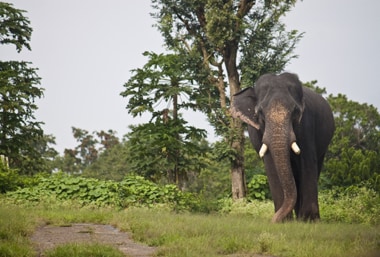Set in the stunning and serene environs of the Nilgiri Hills (Mudumalai translates as ‘old hills’ in Tamil), this wildlife sanctuary, one of India’s first, has the largest population of elephants in any one area in the country (there are estimated to be around 600 of these big creatures). No wonder it’s so popular. It’s also the best destination in Tamil Nadu for close encounters with inhabitants of the wild. The forests neighbouring the sanctuary are equally enjoyable for the wildlife aficionado.
Mudumalai forms part of the massive 3000sq km Nilgiri Biosphere Reserve – to the north is Bandipur National Park, on the Tamil Nadu-Karnataka border (which has a similar terrain), and to the west is Wayanad Wildlife Sanctuary. Spread across the states of Tamil Nadu, Karnataka and Kerala, the Nilgiri Biosphere Reserve encompasses Mudumalai, Nagarhole and Bandipur national parks, and Wayanad Wildlife Sanctuary.
Mudumalai, in facts, sits at the point where these three southern states meet, an area of multiple habitats and a diversity of wildlife. Contributing to the wealth of flora here is the presence of two weather systems – the southwest and northeast monsoon. Mudumalai’s western portion receives the southwest monsoon, while the eastern half receives the northeast monsoon.
History
With big game in big numbers, the forests of Mudumalai were at one time a gathering place for hunters. Now they’re havens for wildlife.
In 1927, Mudumalai became a reserve forest, and 13 years later, the (then) Madras Presidency declared a small portion of the territory as a wildlife sanctuary. The current park area dates back to 1977, and it was designated a tiger reserve in 2008.
With the park abutting three states, Mudumalai has been a source of conflict between Tamil Nadu, Karnataka and Kerala, with all three claiming it as their own. During World War II, the jungles here were used as a training ground for soldiers fighting in Burma.
Geography
Situated – at its highest – 3740ft (1140m) towards the north-eastern side of the Nilgiris, in the densely-wooded foothills of the ‘Blue Mountains’, Mudumalai is made up almost wholly of deciduous forest – tropical-moist in the western part, dry towards the east (alongside thorn-scrub). There are also dells and canyons here, while in the lower reaches, you’ll come across grassland (elephant grass, bamboo) and marshland. The Moyar, a tributary of the River Bhavani, flows in a north-south direction in the park.
Weather
The best time to visit Mudumalai is between the months of December and June, and also during, and just after, the monsoon rains, which lash the region between April and June (the months of October and November also experience rainfall).
Flora and FaunaBesides the park’s many herds of elephants, Mudumalai’s sprawling canopy holds wildlife aplenty, including langurs (common and Nilgiri), bonnet macaques, gaurs (Indian bison), chital, sambar, hyenas, jackals, dholes (wild dogs), wild boar and sloth bears. Meanwhile, muntjacs, or barking deer, can be spotted in the moist-deciduous areas of the park, where the undergrowth is denser.
The elephants (and also gaurs) frequently move to and from Mudumalai into Bandipur – at any one time, there are around 400 elephants in the park. Tigers and leopards are also known to roam the reserve though sightings are infrequent (there are more chances of spotting a leopard).
Among reptiles, lizards and snakes are commonly seen, as are monitor lizards. Meanwhile, in the Moyar, you’ll come across marsh crocodiles and otters.
Over 300 species of birds have been observed here, prominent among them being woodland species. Regularly spotted are the Malabar grey hornbill and the white-bellied woodpecker, while also resident within the sanctuary’s premises are the Malabar trogon, changeable hawk-eagle and collared scops owl. Mudumalai’s birdlife (some rare) can be best spotted from the machans and saltlicks near the Moyar and other watering holes.
Mudumalai National Park also boasts an incredibly rich flora, among which the blazing orange flowers of the flame of the forest tree stand out, interspersed with the yellows of the Indian silk cotton tree and the reds of the Indian coral tree.
How to reach
Mudumalai is 64km southeast of Ooty and 91km to the northwest of Mysore; it is separated by the Ooty-Mysore road. Buses from Ooty going to Mysore and Bangalore stop off at the park’s entrance, at Theppakadu, a journey of some two-and-a-half hours. Buses also ply between Theppakadu and Masinagudi (also close to Bandipur sanctuary) every couple of hours.
The nearest airports are at Coimbatore (160km) and Bangalore (245km), while the nearest railheads are at Ooty (67km) and Mysore (90km).







 Share Via
Share Via


